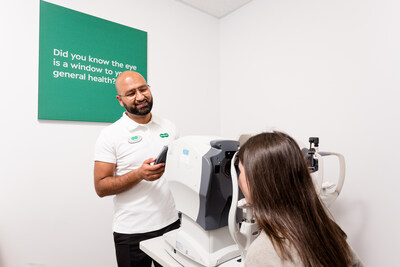Specsavers Canada Highlights National Vision Gap: One-Third of Canadians are Overdue for an Eye Exam
New "Canada Eyecare Report 2025" outlines barriers to accessing eyecare, which may prevent early detection of eye diseases
TORONTO, Oct. 9, 2025 /CNW/ - One in three Canadian adults are overdue for an eye exam, and 17% report their last eye exam was over five years ago, according to the Canada Eyecare Report 2025, released today by Specsavers Canada for World Sight Day. Based on a national survey conducted by Angus Reid Group, the report provides valuable insights into Canadian attitudes toward eye health and barriers to seeing an optometrist.
"The survey reveals a significant eyecare awareness problem in Canada," said Naomi Barber, Clinical Services Director at Specsavers Canada. "Lack of knowledge about eye health is causing many Canadians to delay essential care and possibly put their sight at risk."
Key Findings from the Canada Eyecare Report 2025:
- Affordability is a significant barrier to care. More than half (51%) of Canadians identify cost as a concern when accessing optometric care. Lack of extended benefits coverage is a barrier to getting an eye exam, and there is confusion around provincial coverage: 61% of people who qualify don't think they are covered.
- Many of the people who need eyecare the most are not receiving the care they need. Children, seniors, and people with diabetes are less likely to receive care at recommended intervals, underscoring a critical gap in preventative care delivery.
- Canadians underestimate asymptomatic eye disease, delaying essential care. 42% of Canadians say that if they had a problem with their vision, they would know it, while 38% say they would wait until symptoms appear. In fact, sight-threatening conditions can develop without symptoms. Routine eye exams are the key to detecting sight-threatening conditions before they impair vision. Comprehensive eye exams using a 3D scan known as optimal coherence tomography (OCT) significantly improve detection of early eye disease.
- Myopia is significantly accelerating. Nearly half (46%) of Canadians are reporting a diagnosis of myopia (nearsightedness), according to the survey. The rate of myopia among children and teens is rising steeply, yet only 18% of Canadians are aware of this increase, and just 10% are aware of the link between myopia and sight-threatening conditions.
"The Canada Eyecare Report 2025 is a pivotal step in expanding awareness about the importance of routine eye exams and how we can unlock the barriers that currently exist in Canada," said Barber, "We know that 75% of vision loss is preventable and treatable1. Advanced diagnostic tools like OCT help optometrists detect and monitor eye health changes before they impact daily life. We encourage all Canadians to book a comprehensive eye exam."
The Canada Eyecare Report 2025 was developed with input from vision health organizations including the Canadian Association of Optometrists, Canadian Council of the Blind, Diabetes Canada, Fighting Blindness Canada, Indigenous Children Eye Examination and the International Agency for the Prevention of Blindness.
Through this report, Specsavers seeks to bring visibility to crucial issues around eye health and help reduce avoidable blindness caused by uncorrected vision problems and undiagnosed eye diseases.
The Canada Eyecare Report 2025 is available at https://www.specsavers.ca/eye-health/eyecare-report
About Specsavers
Specsavers is an optometrist-owned business that entered the Canadian market in late 2021. Since then, over 165 locations have opened across the country, in B.C., Alberta, Ontario, and Manitoba. Specsavers recently announced a strategic expansion to open over 100 additional stores before the end of the year, extending reach into five new provinces and one new territory. As part of Specsavers' commitment to accessible eyecare, Specsavers equips every location with optical coherence tomography (OCT) technology, which helps optometrists to detect sight-threatening conditions, such as age-related macular degeneration, glaucoma and diabetic eye disease, in their earliest stages.
Founded in the UK more than 40 years ago by optometrist husband-and-wife team, Doug and Mary Perkins, there are now more than 2,700 Specsavers healthcare businesses globally, serving over 44 million patients and customers. Specsavers is driven by its purpose of "changing lives through better sight" and aims to transform the way Canadians experience eyecare by offering exceptional service, advanced clinical equipment and affordable and quality eyewear.
These are the findings of an online survey conducted from February 14– 19, 2025, among a randomized sample of 2,022 Canadian adults who are members of Angus Reid Forum. The sample was balanced and weighted to be representative of adults nationwide according to region, gender, age, and education, based on the Canadian census. For comparison purposes only, a probability sample of this size would carry a margin of error of +/- 2.2 percentage points, 19 times out of 20. Discrepancies in or between totals are due to rounding.
____________________ |
SOURCE Specsavers Canada



